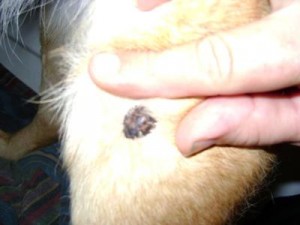Answering Common Questions about Moles on Dogs
You are playing with your pup one day and notice that there is a mole on the skin. You may have some questions about these moles. The first and best answer for any question is to talk with your vet. However, if you are waiting on an appointment, here are some common questions about moles on dogs:
First, is it normal for dogs to grow moles? Actually, moles can appear on a dog, especially as they grow older. Some dogs get only a few while others appear to get many more.
 Can moles on dogs be cancerous? The answer to that is yes, but it is not that common. Just like in humans, a mole can be an indicator of skin cancer in a dog. When you take your dog in to the vet, it is important to point out any moles that appear suspicious. That will give the vet a chance to look at the mole and evaluate it. In the vast majority of cases, moles are benign and nothing to worry about.
Can moles on dogs be cancerous? The answer to that is yes, but it is not that common. Just like in humans, a mole can be an indicator of skin cancer in a dog. When you take your dog in to the vet, it is important to point out any moles that appear suspicious. That will give the vet a chance to look at the mole and evaluate it. In the vast majority of cases, moles are benign and nothing to worry about.
Are certain dogs more prone to moles? In general, dogs with darker skin seem to have more moles than those with lighter skin tones. The skin tone of a dog is not their fur color. When you part the fur, you will see the color of the skin underneath. That is what the indicator is.
What can cause non-cancerous moles on dogs? The moles that quite often appear on dogs are sebaceous adenomas. These are slow growing growths just under the skin. These are most commonly benign and nothing to worry about. However, if you see these moles change, it is important to point it out to your veterinarian.
Another cause of these moles may be exposure to excessive sunlight. Genetics also seem to play a part. Some dog breeds, like the boxer, tend to have more moles than others do. This plays a factor, but is not always an indicator of problems, as many individual dogs in these breeds may have no moles at all.
Where do moles on dogs most commonly appear? These moles can appear on any part of a dog’s body. When you run your hand down the body, you can usually feel the slight bumps that indicate a mole is present. You will be able to see them clearly in the lining of the ears and along the underbelly in most breeds.